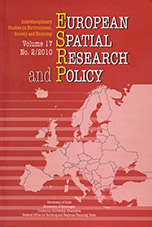Regional Inequalities in the New European Union Member-States: Is there a 'Population-Size' Effect?
Regional Inequalities in the New European Union Member-States: Is there a 'Population-Size' Effect?
Author(s): Dimitris KalliorasSubject(s): Review
Published by: Wydawnictwo Uniwersytetu Łódzkiego
Summary/Abstract: The new European Union member-states (EU NMS),1 that were formerly planned economies of the Eastern bloc, provide a quasi laboratory environment (natural experiment-like conditions) for the empirical examination of spatial inequalities. The experience of the EU NMS is a unique situation, where relatively closed economic systems opened, almost at once, to the world economy and, at the same time, market mechanisms replaced central planning (Petrakos, 2008; Kallioras and Petrakos, 2009). Thus, understanding the driving forces that configure the spatial pattern of development in the EU NMS may provide valuable insight for theory and policy. The paper evaluates regional inequalities in the EU NMS, in terms of per capita Gross Domestic Product (GDP), trying to detect a ‘population size’ effect. Population size is considered to be one of the driving forces of spatial inequality. Traditionally, small countries were considered to be almost ‘dimensionless’ or ‘one-region economies’ (Petrakos et al., 2005a) and, thus, intuitively, spatial inequality in small countries was expected to be diminutive (Felsenstein and Portnov, 2005). The spatial variation of income is considered to be rather insignificant in small countries, which affects the mix of development policies disproportionately against spatial policies and in favour of sectoral policies (Petrakos et al., 2005a).
Journal: European Spatial Research and Policy
- Issue Year: 17/2010
- Issue No: 2
- Page Range: 107-116
- Page Count: 10
- Language: English

